What are compression socks and how do they work?
Compression socks provide gentle pressure on the foot and ankle. This stimulates blood flow and circulation to help with the return of venous blood back to your heart. Compression stockings can also aid in relieving pain and promote healing for certain health conditions related to the lower leg and feet. Compression stockings work by providing compression, which increases tissue oxygenation and blood flow. Compression socks are able to do this without restricting flexibility or movement. Compression socks are recommended for many people including those who have surgery, diabetes, circulatory disorders, muscle fatigue, muscular injuries and if you are on your feet all day long. Compression socks are worn by athletes as well as women with symptoms of swelling in the lower legs, varicose veins, pain in the feet or legs, thrombophlebitis, thrombosis and post-phlebitic syndrome. Compression socks are also worn by pregnant women to help prevent deep vein thrombosis (DVT) or blood clots. Compression socks have no age limits. They can be worn by both young and old. They do not cure the cause behind the problem but support your body when needed. Compression stockings can also help improve blood flow to swollen feet and ankles.
You may hear compression socks referred to as graduated compression, gradient compression or medical compression socks. Compression therapeutic support hose is another term for compression socks. Compression stockings is a term mainly used in the medical profession which does not always include all of the features that compression socks have. Compression therapy support hose often has a negative connotation because it has been linked to old granny stockings and also because they are generally more expensive than regular compression socks.
Luckily, these old days are gone. And in today’s world, you can have it all – the healthy benefits of compression wear and a stylish and cute look.
Compression socks have no age limits. They can be worn by both young and old. They do not cure the cause behind the problem but support your body when needed. Compression stockings can also help improve blood flow to swollen feet and ankles.
You may hear compression socks referred to as graduated compression, gradient compression or medical compression socks. Compression therapeutic support hose is another term for compression socks. Compression stockings is a term mainly used in the medical profession which does not always include all of the features that compression socks have. Compression therapy support hose often has a negative connotation because it has been linked to old granny stockings and also because they are generally more expensive than regular compression socks.
Luckily, these old days are gone. And in today’s world, you can have it all – the healthy benefits of compression wear and a stylish and cute look.
How many hours a day should you wear compression stockings?
Generally speaking, there is no valid reason why you shouldn’t wear your pair of compression socks 24 hours each day. But, unless your doctor recommends wearing them 24/7, this is usually not necessary. The amount of time that is perfect for your personal needs and condition depends on many individual factors, such as your profession, how long you need to sit or stand during the day, your daily schedule, how fast your blood flows without compression, your hobbies and everyday activities. There simply is no “one-size-fits-all solution”. When you sit or stand for lengthy amounts of time during the day, blood will pool in your veins. When you lie down at night, however, gravity’s effect fades away, allowing blood to flow more effectively. It’s also preferable to let your skin breathe without the stockings for a while before going to bed. If you do choose to put them on at night, just make sure they’re comfortable enough to give you a good feeling during the whole night. The short answer to this question, how long you should wear compression socks is: Wear them as needed.Is there a downside to wearing compression socks?
As with everything in life, for some women compression socks can feel uncomfortable. This is mostly a temporary effect and you need to get accustomed to this feeling first. Give them a few days and you’ll reap the benefits without any side effects. In rare cases, compression stocks can cause the following problems:- Cut off circulation. Compression socks and stockings are designed to provide constant pressure for the purpose of promoting circulation. However, when they aren’t worn correctly, they can have the adverse impact of restricting blood flow in your legs.
- Itching and skin irritation. Compression socks can irritate skin and cause itching. When compression socks are not worn correctly, redness and temporary dents in the skin around the sock’s edge may appear.
- Bruised legs. If you have dry skin or are in a location with harsh, dry air (such as on an airplane), your skin is more likely to chafe or scrape. Compression socks can cause wounds, abrasions, and bruises in people who have a damaged skin barrier. When compression socks or stockings are worn correctly, this is significantly less of an issue.
- Allergic reactions. This is very rare, but your body may react to the material of the stocking.
What brand of compression socks is the best?
There are literally hundreds of brands out there that you can buy your compression socks from. And while we do have our own brand here at BaronActive and we’re offering many different variations for all kinds of situations, conditions and purposes, here are our top 10 picks: Best Overall Compression Socks: CEP Progressive + for womenBest overall compression socks
OVERALL SCORE
PROs
- Super comfortable
- Snug fit
- Graduated compression
CONs
- Expensive
- Difficult sizing
Best Compression Socks for Runners: Physix Gear Sports
Best Bang for Your Buck: SB Sox Compression Socks
Best Ankle Compression Socks: BaronActive Heel & Foot Pain Socks
Best ankle compression socks
OVERALL SCORE
PROs
- Super affordable
- Great padding
- Awesome design
CONs
- Size can be hit or miss
Best Compression Socks for maximum circulation: Sockwell Women’s Elevation Firm Graduated Compression Sock
Best Compression Socks for long days on your feet: Sockwell Women’s Circulator Moderate Graduated Compression Sock
Best stylish compression socks: NEWZILL Compression Socks
Best stylish compression socks
OVERALL SCORE
PROs
- Super comfortable
- Snug fit
- Cool Styles
CONs
- Less compression than advertised
- Difficult sizing
Best Recovery Compression Socks: Mojo Coolmax Recovery & Performance Sports 20-30 mmHg Compression Socks
Best Wide-Calf Compression Socks: Levsox Wide Calf Compression Socks
Most fancy compression socks for women: Wonder Woman Compression Socks
All of the mentioned compression socks were tested by us and our trusted partners. We took our customer’s recommendations into account and that’s why we’re recommending these brands to you.
A compression sock does best when it fits the user correctly, both in terms of actual size and how well it stays fitted throughout the day. We evaluated how true-to-size the socks were and whether they kept from sagging when worn for lengthy periods of time.
The amount of compression a sock provides is determined by its compression rating, and the purpose is entirely dependent on these numbers. A person’s requirements can vary significantly (and are certainly different from one individual to the next), so we studied how many size options and ratings each brand provided to see if they met a wide range of requirements.
Compression socks aren’t inexpensive per pair, so it’s critical that they last long enough. This necessitated stressing the socks in conditions outside their normal usage to see how well they stood up. If some sagged due to readily collapsing or ripping, we knew they’d breakdown much quicker than we wanted in the long term.
Compression socks may be pricey, but testing their value isn’t as easy as it appears. Rather, the true value is a mix of the above three elements plus how much it costs. We believe that buying a high-quality product that lasts longer is usually preferable to spending less on something lesser.
What compression socks do doctors recommend?
All of the doctors we spoke to during our research for this article said that they recommend starting with lighter compression for new wearers. The pressure in compression socks is measured in millimeters of mercury (mmHg). Some compression socks provide a light pressure level of 10 to 20 mmHg, while those on the firmer side have a pressure level of 20 to 30 mmHg. Compression socks should fit comfortably but not so tightly that circulation is restricted.
Starting with lighter compression means 10 to 15 mmHg in numbers. That is typically a good starting point and you want to start a bit lower if you’re new to wearing compression stockings. It’s fine to remove your compression socks if you’re new to wearing them but find them unpleasant throughout the day. Give your body some time to adjust to them, just like when you need to break in a new pair of shoes.
If you show moderate to severe swelling, you might need to go a bit up and try 20 to 30 mmHg compression levels. And in severe cases, doctors prescribe 30 to 40 mmHg. But these socks are custom fit and are not readily available in pharmacies or on the internet.
One more factor to consider is whether you should wear below- or above-knee socks. Below-knee socks are more popular. If you have thicker calf muscles, I recommend using above-knee compression socks. Sometimes an extra few inches of fabric might make the top of your calf feel more comfortable, so it isn’t as uncomfortable on your skin.
Is it better to wear compression socks at night or during the day?
Most of the compression socks that you can find in stores are designed to be worn during the day. You should put them on as soon as you wake up, while still in bed. Your feet, calves and legs tend to swell during the day and wearing your compression socks right at the beginning of the day makes it a lot easier to put them on while providing the necessary support throughout the whole day.
Before you go to bed you should take your compression socks off. It is necessary to wash your legs once a day, so if you’re taking a bath or shower after work or before going to sleep, you can take your socks off right before. If your socks are really tight and you encounter problems removing them, you can do this procedure during showering or bathing. Just as a little tip.
You can, of course, wear compression socks at night. But we recommend using a second pair, maybe with a little lighter amount of compression for better comfort. But if you’re happy with your socks and want that extra compression at night, it’s totally fine to wear the same model. Buy yourself some more pairs so you can switch them daily. Just make sure to give your skin some time to breathe between those changes.
How long does it take for compression socks to work?
For most people (unless using very high compression levels or wearing them for extended periods of time), it can take up to 10 minutes before feeling relief. Compression socks gradually improve circulation and help prevent blood clots from forming. But the effect of compression on your body is immediate – you’ll notice it right away.
Why do my legs feel better when I wear compression socks?
The pressure these stockings put on your legs helps improve the functioning of your blood vessels. The arteries that deliver oxygen-rich blood to your muscles can relax, allowing for free circulation of blood. Blood is pushed back to your heart via the veins, which get a boost in power.
Compression stockings can help you avoid tired and achy legs. They can also aid in the reduction of swelling in your feet and ankles, as well as assist with the prevention and treatment of spider and varicose veins. When you stand up, they may prevent you from feeling dizzy or lightheaded.
Who should not wear compression socks?
If you have peripheral vascular disease in your lower extremities, you should avoid wearing compression socks. Compression socks may aggravate ischemic disorders by providing pressure. Because neuropathy prevents diabetic people from detecting changes in their feet, they are more prone to complications. So if you have a medical history, please make sure to speak to your healthcare provider before buying some compression stockings on your own.
How do you know what size compression socks to buy?
Most brands show size charts on their websites that you can take as a reference. We at BaronActive generally use two metrics to make sure that a pair fits our customer.
For our thigh-high compression stockings, we show the exact measurements of the thigh, calf and ankle. Just take a measurement tape and simply wrap it around the body part you want to measure. Just like a tailor would do. That ensures you will always have the exact size for your compression stockings.
Calf compression socks show the necessary or circumference ranges of the ankle and the calf. Again, measure with a tape and you’re on the safe side.
When it comes to ankle compression socks, we found that circumference was not the best way to choose the best size. Instead, we found out by experience that your shoe size is a better way to determine whether a pair will do the job or if it’s too small or loose.
What does 15-20 mmHg mean for compression socks?
Because they are designed for different applications and health benefits, women’s compression stockings are available in a variety of pressures. The level of compression is listed in millimeters of mercury (mmHg). The different levels are as follows:
- Extra light. The pressure in compression stockings ranges from 8 to 15 mmHg. These are frequently utilized to treat mild symptoms such as weary limbs and enhance circulation. Because they’re often used for travelling, these are sometimes known as “flight socks” and are available without a prescription at your local pharmacy or online.
- Light. With a pressure of 15-20 millimeters of mercury, these are still regarded as low-pressure. They can be purchased without a prescription because they are on the lower end of pressure.
- Moderate. The most common pressure level for compression socks is 20 – 30 mmHg of mercury (mmHg). They are frequently used by nurses and other professionals who work on their feet for lengthy periods of time. These are generally the finest compression socks for women.
- Firm. These compression socks for women have a 30 – 40 mmHg level of pressure and firmness, which is used by those with more serious health issues.
- Extra Firm. The pressure of 40-50 mmHg is quite high and may only be used by individuals who have received a prescription from their doctor for severe health issues such as post-thrombotic syndrome or other disorders.
Now that you know the different compression levels you can easily take that information and make a choice on what levels may suit you best.
Do I need a prescription for compression stockings?
Compression stockings are available over the counter at your local pharmacy. If you have a medical condition, make sure to speak with your doctor about compression therapy to see if it’s recommended for you.
If you have serious health concerns, then only consult with your physician before taking action. Compression socks can be purchased without a prescription but they are only available in specific compression levels.
As stated above, when purchasing Compression Socks For Women you need to ascertain your needs, the sizing and the compression pressure in order to find the best Compression Socks for you personally.
Light and moderate level compression socks are available on the internet or at your local pharmacy. Firm or extra firm levels generally need a prescription, so if you are in severe pain, you should see your doctor as fast as possible to get a custom-made pair prescribed.
How do I know if I need compression socks?
Compression stockings are becoming increasingly popular among women. You should consider getting yourself a pair of compression socks or compression stockings if you are among the following types of women:
- Women who stand for long hours. The average workday time for Americans, according to a 2014 national Gallup poll, was 9.4 hours per day. Many women have little or no leisure time to relax and take a breath because they are on their feet all day long. As a consequence, lifestyles have altered, and diseases have proliferated. Fatigue is prevalent in many professions today and better circulation through compression socks can help with this.
- Women with certain professions. Wearing compression stockings has the added benefit of reducing tiredness and swelling in the feet and legs, as well as lowering the chance of varicose veins developing from standing on one’s feet for long periods of time. Compression socks may help hairstylists, nurses, waitresses, retail employees, and other women who spend a lot of time on their feet.
- Women who sit for long hours. Women who spend a lot of time sitting in industries that necessitate a lot of sitting also benefit from wearing compression socks. People who spend a significant amount of time sitting at a desk without getting up are prone to foot edema and blood clots as a result of poor circulation.
- Sporty women. Compression stockings, which are sometimes worn for athletic competitions or sports activities, can benefit athletes who want to enhance their sports performance. Compression gear for athletes is recognized to enhance circulation and increase the amount of oxygen that reaches the muscles, whether knee-high, thigh-high or full hose. The advantages of compression gear are not restricted to the recovery process; they extend into other areas as well. As a result, many athletes claim that their performance is significantly enhanced. Furthermore, wearing compression apparel during a rigorous workout can reduce lactic acid production in the muscles, which helps to minimize soreness and cramping after exercise.
Additionally, compression socks are required for certain patients. Compression therapy has developed into a widely accepted state among specialists and is widely used for a variety of health conditions. Here are the most common medical conditions they’re used for:
- Edema. The limb condition known as edema is the buildup of bodily fluids in tissues, especially the feet and hands.
- Varicose Veins. Blue or dark purple varicose veins are painful and can affect your mobility. They’re often knotted and protrude from the legs.
- Venous Insufficiency. In this situation, the veins are unable to effectively pump deoxygenated blood back to the heart.
- Deep Vein Thrombosis (DVT). When blood clots develop in the deep veins of the legs, it’s known as deep vein thrombosis (DVT). People who spend a lot of time sitting still are especially likely to get blood clots in their legs. Compression socks and support hosiery can aid in the treatment of DVT.
- Lymphedema. When the body swells abnormally as a result of an accumulation of lymph fluid, it is known as lymphedema.
- Lipodermatosclerosis. The inflammation of subcutaneous fat is called lipoedema, and it may benefit from the application of compressive stockings.
- Leg Ulcers. Leg ulcers are unhealed sores or open wounds. The most typical cause of this problem is poor circulation, although it might also be caused by a variety of diseases.
- Pregnancy / Maternity. Wearing compression stockings can assist with circulation when pregnant women are confined to bed rest by their doctors. After giving birth they can still be of great help to reduce swelling and improve circulation to recover as fast as possible.
Can compression socks cause blood clots?
No, the opposite is true. Blot clots develop through long periods of sitting or standing. Take a long flight as an example. Due to the minimal movement, the blood circulation slows way down. Blot clots can develop. Compression socks help with blood circulation and therefore prevent blood clots from developing.
What happens if compression socks are too tight?
When your compression socks don’t fit properly and are too tight, blood circulation may be cut off. This can result in tingling or numb legs, feet or toes. You may also notice a pale color of your skin. After taking the socks off, your skin and blood circulation will get back to normal, so these are only temporary signs.
However, it is really important to get compression stockings in the right size for you. When you first start out and don’t have any experience, this might be a little game of trial and error. Try a few brands and different levels and stick to the ones that work best for you. Though this can cost you a little more in the beginning, the right size and levels will pay off for you.
Do ankle compression socks work?
Yes, absolutely. Ankle compression socks or sleeves work as well as their knee-high or thigh-high siblings. Ankle compression socks are usually way easier to put on and off. On the other side, they only provide compression to the toes, foot and ankle. If you only need to treat these areas of your body, we recommend getting yourself some pairs of them. If you want or need the compression to work higher on your leg, your claves or even thighs, you’re better of choosing knee-highs or thigh-highs.
Here at BaronActive we have all kinds of compression socks available for your to try. Whether you need ankle compression socks, ankle compressions sleeves, toeless socks, knee-high compression socks or thigh-high stockings, we have you covered. So please make sure to check out our shop here.
Do compression socks help with restless leg syndrome?
Restless legs syndrome (RLS) is linked with neurological disorders that produce strange and uncomfortable leg movements at night, according to research. Patients frequently describe the feelings and symptoms as itching, pulling, or a twitching sensation in the legs. The symptoms typically manifest while sitting or sleeping.
Wearing compression socks has several advantages, one of which is improved circulation and muscle massage. Those who suffer from restless leg syndrome may experience relief and benefit from even a modest amount of graduated pressure in the 15-20 mmHg compression range.
Compression socks help to decrease leg swelling, improve blood circulation, and ease muscular tension by compressing the lower body. Patients who experience better sleep quality as a result of more oxygen reaching their legs and less pooling of blood in their feet will benefit from this product.
In short, yes, compression socks are great for patients who want to treat their restless leg syndrome.
Can compression stockings lower blood pressure?
Compression socks squeeze your lower legs and increase blood flow. They put pressure on your blood, so it’s reasonable to believe that compression clothing raise your blood pressure. This isn’t completely accurate. When individuals with healthy blood pressure wear compression stockings or socks, they do not develop high blood pressure (hypertension). Compression garments worn above the knee have no sustained impact on your blood pressure.
Surprisingly, other types of compression garments have been found in studies to help treat orthostatic hypotension (low blood pressure) by reducing abrupt changes in systolic blood pressure; however, knee-high compression socks are not advised for this purpose. Most research indicates that, when it comes to blood pressure, knee-high compression socks and stockings have little to no impact on blood pressure.
What can I use besides compression stockings?
If you don’t want to wear compression stockings, there are a few alternatives that you can try. Compression wraps and garments may provide similar benefits and relief. There are several brands, like DonJoy and McDavid, that offer products such as compression sleeves and supports.
Compression wraps also reduce muscle fatigue during heavy exercise or high-intensity sports. When muscles are fatigued, they can produce lactic acid that leads to muscle stiffness and post-exercise soreness. Using a knee compression wrap after exercise helps reduce the risk of these negative effects.
Another alternative to compression socks is using compression sleeves. Compression sleeves are easy to put on and apply the same amount of pressure on your feet, legs, calves or thighs as normal compression socks would do. But they only cover the body part that you want to treat and nothing else. Compression sleeves look like bandages but with the benefit of actually improving circulation.
Splints can have a temporary effect if the mechanics of your foot are out of their proper position. They can also help maintain or improve muscle function, which can be very beneficial to people who have chronic nerve conditions that cause muscle weakness in their feet. A physical therapist may suggest using a splint at night, during periods when most symptoms occur.
Are compression socks good for elderly?
It’s critical for seniors who are moving into senior communities or nursing homes to be proactive about maintaining their health. It is essential to take good care of your health in order to live a joyful, comfortable existence. Compression socks, which help to reduce swelling and improve circulation, are one of the most important items for people who have health difficulties. Compression stockings are cheap and readily available, with significant advantages for seniors. Here’s why compression socks should be in every senior’s wardrobe.
With age, problems with the muscles and joints are becoming increasingly common. This pain can be extremely debilitating, restricting mobility and independence in people over the age of 65. Compression socks can help with chronic pain linked to aging, such as varicose veins or ankle and knee problems. They help to decrease swelling, which is generally a symptom of discomfort. Seniors benefit from compression socks in terms of increased mobility and independence while recovering from ailments or injuries affecting the lower legs.
Many seniors face the difficulty of finding methods to do the activities they used to love or even keep working if they choose. If you have pain in your legs and feet when standing, it may be tough to be up and about. Compression socks are highly beneficial for those who need to stand and walk for lengthy periods of time. This means that seniors may exercise, socialize, or even work with greater ease and flexibility.
Is there an easy way to put compression stockings on?
Putting compression socks on is maybe the most difficult thing about them. The first and most important rule of wearing compression stockings is not to attempt to put them on until you’ve had a chance to completely dry off! If your skin is wet or if you have lotion on it, it will be virtually impossible to put them on. While unscented lotions can be used on any type of fabric, they may also cause damage to the fibers in your stockings. If you want to wear your stockings and don’t want them to deteriorate, skip the lotion. Check the care instructions that came with your stockings to see whether it’s necessary.
When your skin is completely dry, you’re ready to apply them. Sit on the edge of your bed and place one foot on a chair, the wall, or a dresser. Pull each sock over one leg at a time. If you have to, lie down while rolling them up your leg. Take a pause if necessary – it’s tough when you’re just getting started. If you need extra grip, use water on your hands.
If you’re wearing open-toed stockings, most stocking makers will provide you with a heel slipper to assist you put them on. It’s a smooth fabric or slippery paper that you can use to slide the stocking over your heels and then pull the slipper out through the toe opening once the stockings are in place.
How high should compression socks go?
If you only have pain or want to treat swelling in your toes, feet or ankles, getting a pair of ankle compression socks is probably the best idea. Compression socks with an ankle-high height are generally simpler to put on and more pleasant to wear than knee-length socks.
They also have a lot of the same advantages, such as decreased edema and pain in the feet.
In the end, ankle support socks are ideal for everyone, particularly athletes and sports enthusiasts, as well as those who suffer from foot pain that is mild to moderate.
Knee-high compression socks are the most popular variant among women. And they’re probably the best solution for most women out there.
Knee-high compression socks help with pain, swelling and blood circulation in the toes, feet, ankles and calves. So they benefit a wider area of your body.
Our favorites, though, are thigh-high compression stockings. Thigh-high compression stockings may appear to be a difficult commitment at first, but the taller the stocking, the more potential benefits there are. Compression socks not only improve circulation in your legs, but also provide relief for the lower leg muscles, such as your feet and calves. Thigh-high stockings make sure that your knees, quadriceps, and hamstrings aren’t forgotten.
When you can improve circulation in your entire leg, why limit it to just your calves or feet? Compression stockings softly squeeze the leg to stimulate blood flow and venous circulation, which can help prevent leg edema and blood clots. Thigh-high stockings provide the same advantages as calf-high stockings in that they help to improve blood flow and enhance venous circulation throughout your leg. They’re particularly helpful if you’ve had surgery or have restricted mobility.
You may treat spider or varicose veins on your thighs, especially near the back of your leg or knee, with compression by wearing thigh-high stockings. Compression hosiery can alleviate or eliminate spider and varicose veins without surgery, and the higher the stocking, the more skin it covers — and the better your results will be.
How do you wear compression stockings in the summer?
People commonly think of summer clothing as light, loose-fitting clothes. But what if you want to wear compression stockings in the heat or during the summer? Heat can increase leg vein strain and lymphatic problems. Here are some strategies to make wearing compression hosiery in the heat more pleasant.
- Choose knee-high compression socks. Instead of wearing pantyhose, opt for a pair of compression stockings. Compression stockings aren’t as uncomfortable to wear as pantyhose.
- Open-toe compression socks rock. open toe designs help with better air circulation and don’t make your feet sweat as much. Additionally, they are great to wear with sandals or even flip-flops.
- Skin tone is your color of choice. If you intend to wear shorts or a skirt, skin tone colors make it easy to hide the compression stocking.
- Baby powder for easier wear. Consider wearing donning gloves and a little baby powder while putting on your compression stockings. If you’re sweating, the donning gloves make it simpler to put on your compression stockings, while the baby powder keeps the skin smooth.
Takeaways
I really hope we have all your questions answered in this article. And while this article might be a rather long read, we tried to put as much information about compression socks for women in it as we could. So here we have it – the ultimate guide to compression socks for women.
We would love to hear your opinion, as always. And if you have any questions that you couldn’t find an answer to in our guide, don’t hesitate to ask them in the comments or send us an email to support@baronactive.com.
We will hear your feedback and will update this article with all new questions that may arise. So your help is needed to keep this guide the most complete one on the internet.






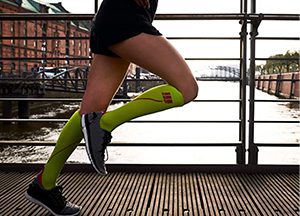
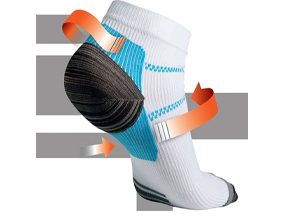





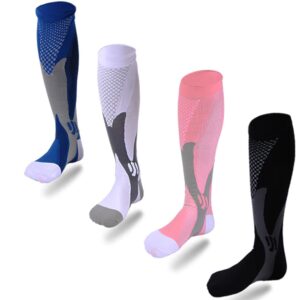
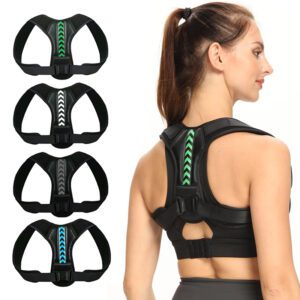
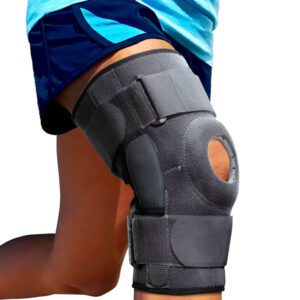

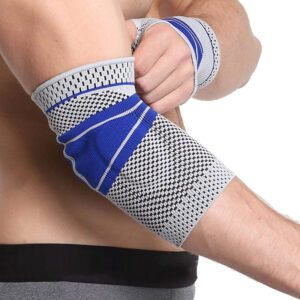
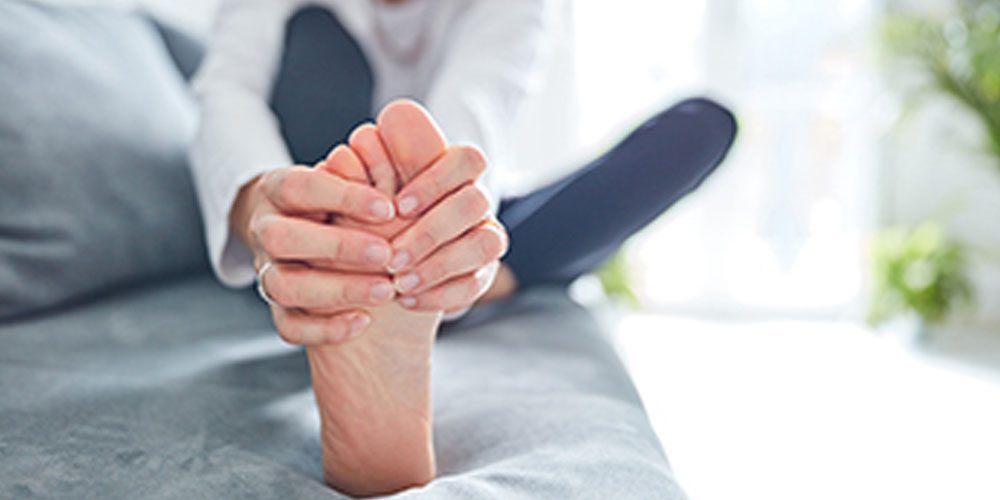
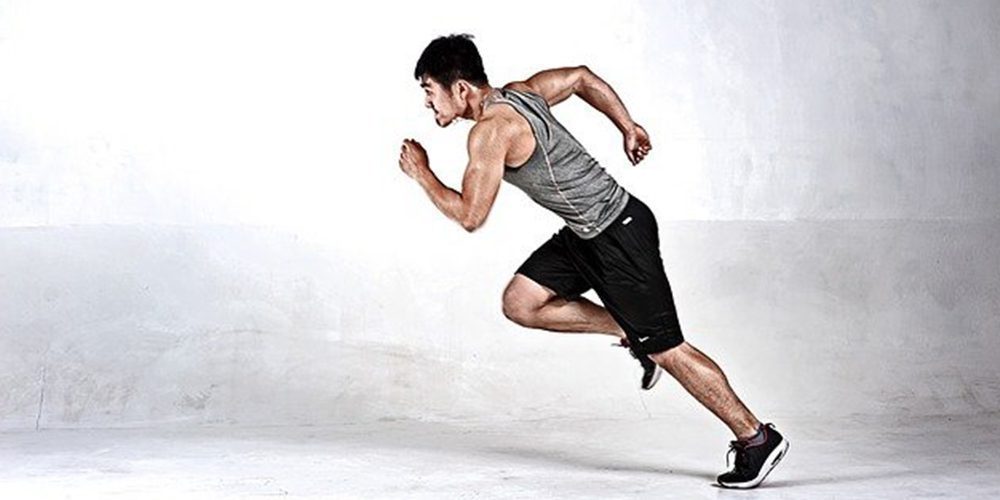
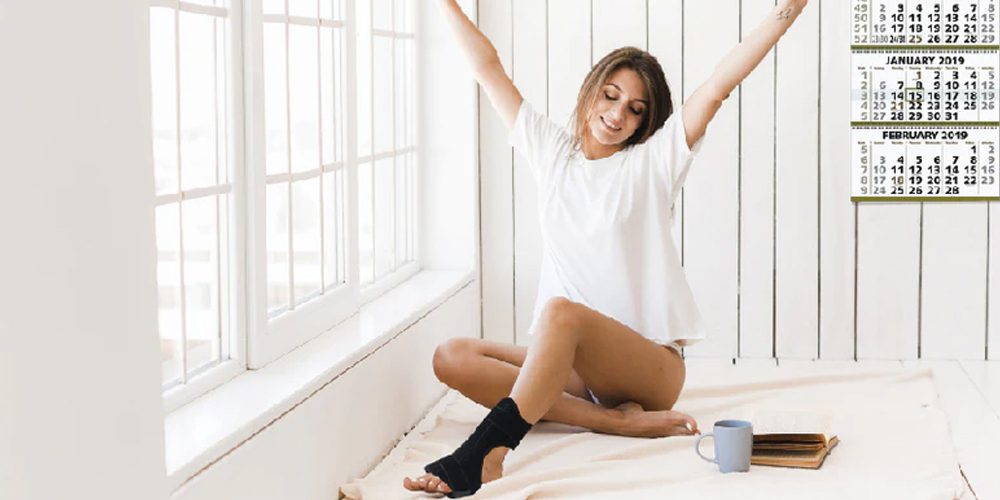


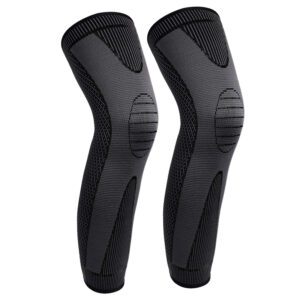


One Response
You should be honest with customers. Compression stockings HURT. If you have arthritis in your hands, they can be nearly impossible to put on yourself (and most of us don’t have anyone to do it FOR us)… even if you don’t, they are extremely difficult to put on and WORSE to take off.
They are universally hideous, and do not fool anybody that they are not what they are: a medical stocking… they CAUSE pain… as you are in pain, you avoid exercise and going out in public.
If you are a woman and under age 80… it looks hideous and screams “OLD PERSON!” and you cannot wear shorts, capris, skirts above the ankle, bathing suits or anything attractive in summer… forget about sandals or open toe shoes. That means you now have to dress like you are Amish and apparently, can never wear anything attractive again in your life.
Oh and they are expensive! and not covered by any insurance I know about! unless you want to wash and wear socks DAILY, you would need between a dozen and two dozen pairs (at an average price of $25+ each)…
Since they are VERY HOT… you will be miserable all summer, sweating and hot… better hope you don’t have hot flashes or menopausal symptoms! imagine being encased in a TUBE of hot, unbreathable fabric… for the rest of your life… while it presses and squeezes on you, causing deep aching pain.
This is real misery for those who have to wear them, and mostly women (since men largely wear pants and don’t have to worry about exposing their feet or legs)… yet it is treated lightly. This is deeply offensive for those who are suffering.